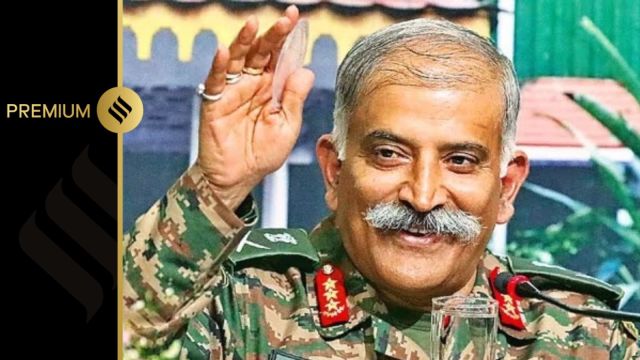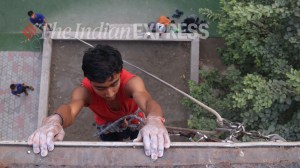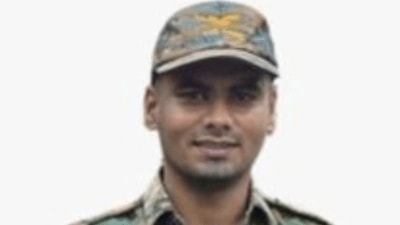Talking about challenges posed by the increased influx of migrants from Myanmar in the past three months, Lt Gen Kalita, in an exclusive interview to The Indian Express, said that a new trend has come to light.

He said that earlier the Myanmar Army would carry out attacks in areas close to the border, which forced several migrants to cross over. Most migrants crossed over to Mizoram while some came over to Manipur.
Story continues below this ad
“But in the last three to four months, the fighting with Myanmar Army has intensified after the launch of operations by the Three Brotherhood Alliance and other pro-democratic groups,” he said.
“With the fighting intensifying, the migration, which was earlier limited to Mizoram-Myanmar border, has now started expanding to the northern side. Earlier, the refugees were only coming into the southern part of Manipur, but now they have started coming towards the northern part of Manipur in the Kamzong district,” he said, adding that this is a recent trend.
Lt Gen Kalita said that multiple Myanmar Army camps have been under attack, leading to the soldiers also crossing over. “We have transported them to Moreh and then sent them back after following the due process,” he said.
He said while several migrants do cross over, many of them also return after a period of time.
Story continues below this ad
“Illegal immigrants have traditionally posed security challenges for the border guarding forces as there is a chance of merging with local population and involvement in smuggling of narcotics and contraband,” he said, adding that unregulated free movement regime provisions pose additional challenges to the forces.
About the situation in Manipur, the Army commander said it is improving, but the problem remains as both communities involved in the conflict are not talking to each other directly.
“The problem may take more time to resolve, but till that happens, somewhere they have to sit across the table and talk it out. Trust deficit is a basic issue and if that doesn’t get resolved, the possibilities of sporadic violence taking place and the threat of some of those instances escalating remains,” he said.
The threat, he said, gets accentuated because of weapons available with both sides — some of which were stolen from police armories and some coming in from Myanmar.
Story continues below this ad
Lt Gen Kalita also said that prior to May 3, when the ethnic violence broke out, the insurgents on both sides had lost their support base as well as relevance in society with people experiencing peace, stability and development in the region.
“But now, insurgents on both sides have tried to assume the role of protector for their own communities. This has given them some relevance as far as Manipur is concerned, which is not good for the overall insurgency and security situation, particularly in Manipur,” he said.
“The fact that they (insurgent groups) were able to recruit new people after a long time is an indication of them regaining some relevance in society.”
On the strategically important Doklam, Lt Gen Kalita said it continues to remain a challenge but the Army has its plans and preparations in place — in terms of adequate infrastructure and deployment — to ensure that India’s interests are taken care of.
Story continues below this ad
He said that since 2017, there has been no further Chinese construction observed towards Doklam — an area less than 100 sq km lying close to the India-Bhutan-China trijunction.
The area is closely observed and even the slightest of aberrations noticed are flagged immediately and resolved during the regular interactions, which take place between the two sides — a mechanism put in place after the two-month standoff between Indian and Chinese troops in 2017.
“We have our plans and preparations in place to ensure our interests are taken care of. After 2017, there has been no further development in those areas which were under dispute at that point of time,” he said.
Lt Gen Kalita, however, said completing the planned infrastructure in time along the Line of Actual Control (LAC) in the Northeast remains the biggest challenge for the defence forces, despite the big push in infrastructure construction in the region.
Story continues below this ad
“Once we have it ready, it will help us enhance our response to any sort of situation developing in that area,” he said.
Lt Gen Kalita said India has developed a focused approach to substantially improve the status of infrastructure in the past few years.
“Looking forward, we are formalising our long-term plans, fast-tracking construction of roads, bridges and defence infrastructure by streamlining our procedures, including fast track clearances in conjunction with civil administration and undertaking review of policies for faster execution of projects,” he said.
At present, there are 19 helipads, 126 roads and eight tunnels under construction in the Northeast, while through 2023, construction of 15 roads and the Nechiphu tunnel was completed. A total 54 of the 662 border villages identified under the Vibrant Villages Programme under the Eastern Command have been identified for priority development.
Story continues below this ad
Citing examples of major infrastructure projects in the Northeast, Lt Gen Kalita said the funds for the Trans Arunachal highway has already been sanctioned and the construction will start soon after the detailed project report of the project is ready. He said the Se La tunnel, set to open soon, will provide all-weather connectivity to Tawang and there has been construction of multiple roads in the Dibang valley.
“Moreover, my priority was to extend forward connectivity to the passes and places which were lacking it. This is still ongoing in some sectors; construction of several laterals for inter-valley connectivity in the Northeast is also underway,” he said, adding that these projects take a longer time to complete due to the difficult terrains in the Northeast, but the work is in progress.
However, he acknowledged that the Chinese are also heavily constructing and strengthening their infrastructure network along the LAC, which includes creation of dual-use infrastructure such as model villages.
Lt Gen Kalita also said that the defence forces have made an earnest beginning towards creation of theatre commands and are committed towards the efforts. “The ultimate goal is to create efficient organisations which achieve combat edge over adversaries in futuristic battlefields,” he said. “It will involve identification of areas of convergence, consensus among the three services, commonality in operational planning process and protocols and integration in all spheres including communication, logistics and supply chain management.”
Story continues below this ad
He said natural calamities such as the GLOF in Sikkim do not affect military operations and training directly as peculiarities of terrain, including climatic conditions, are considered in the planning process.
“Bases located in valleys remain prone to natural disasters but the Army always caters to contingencies, including movement through alternate routes for logistics sustenance and placement of additional equipment,” he said.









